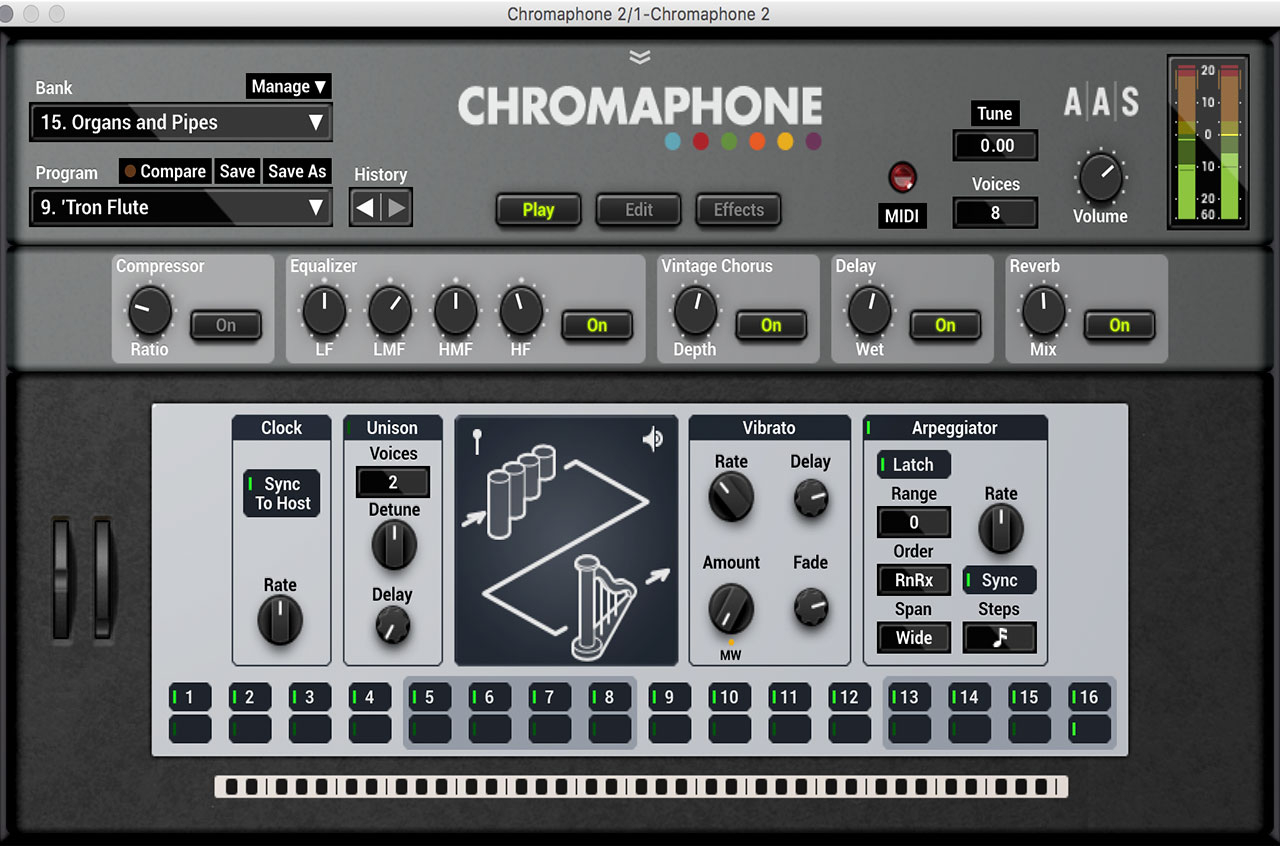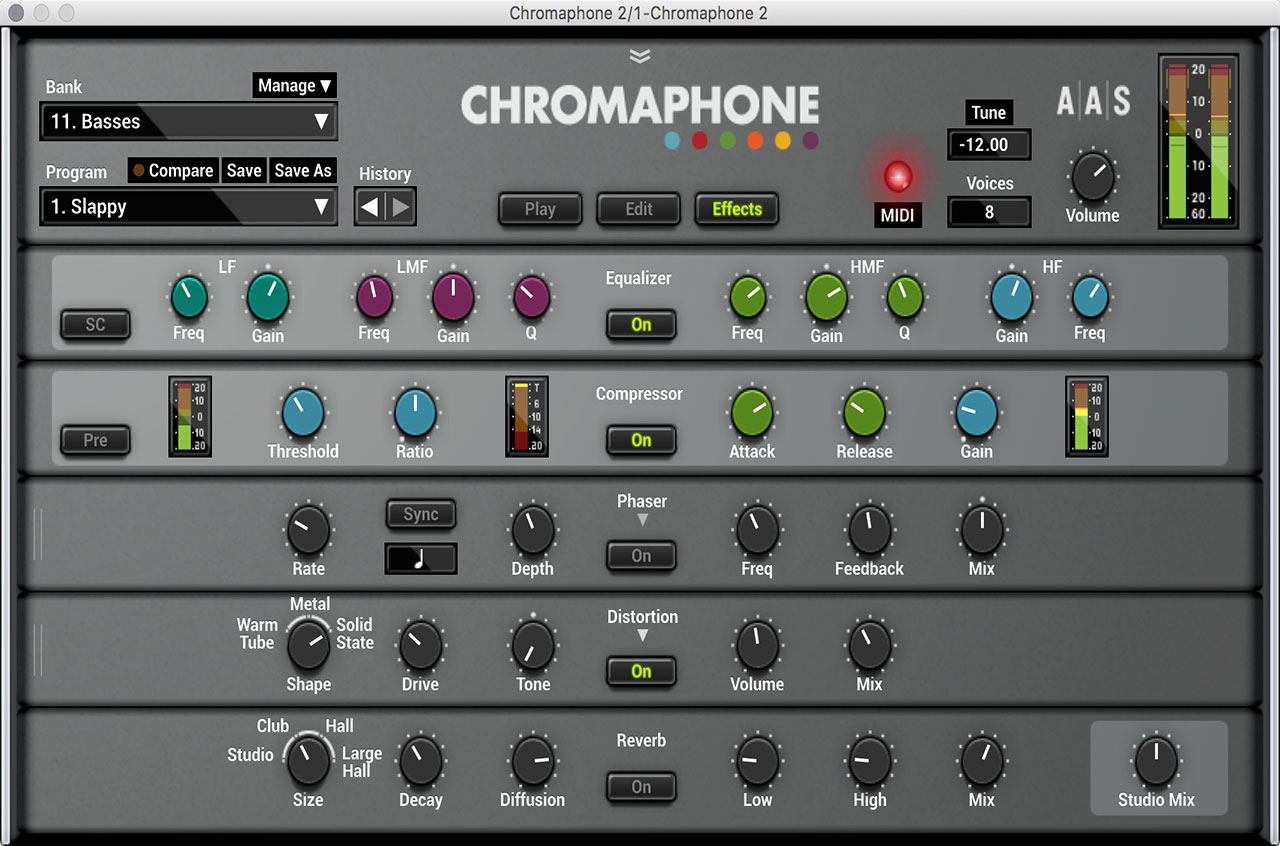- The Canadian sound scientists at Applied Acoustics Systems (AAS) specialise in physical modelling, which is a style of synthesis that differs from your average algorithm. You're given parameters corresponding to the characteristics of real world objects in order to generate sound, rather than typical oscillators. AAS have made a name for themselves over the years with virtual instruments like Tassman, Lounge Lizard and String Studio, which emulate guitars, harps and electric pianos respectively. AAS collaborated with Ableton in 2009 for the Collision plug-in, which accompanied the release of Live 8 and boasted capabilities beyond many of AAS's previous instruments. Collision found new life in 2012 when it was repackaged as a cross-platform plug-in called Chromaphone, and then again in March this year when the latest version, Chromaphone 2, was released.
Chromaphone 2 can run in standalone or plug-in mode, with the latter supporting VST, AU, RTAS and AAX formats. Installation and activation is a painless process, and once completed, you're greeted with an attractive UI that attempts to take some of the mystery out of a somewhat enigmatic synthesis method. It does this with visual representations of the virtual objects that are generating the sound, whether it's an open tube or wooden beam. In Chromaphone lingo, these objects are called Resonators and they're vibrated with mallet strikes or noise sources. You may be thinking that this seems somewhat limited, but there's considerable detail on offer.
There are two resonators to play with and each includes a choice of nine different object types: string, beam, marimba, plate, drumhead, membrane, open tube, closed tube and manual, which lets you create customised resonances by manually selecting four partials. You have fine control over pitch on every resonator as well as common parameters like decay and release. Some of the object types also have additional knobs to control parameters specific to the resonator, such as the radius of the tube or the material of the drumhead. At the bottom of the resonator section there's a slider that serves as a crossfader for the level of the resonators. There's also a button labeled Coupled which, rather than treating the resonators as independent objects, creates a bidirectional flow of resonation. This is one of the main differences between Cromaphone 2 and other physical modelling instruments, including Collision. To get a sense of why the Coupled function could be useful, consider how an acoustic guitar's character is a product of both the strings and the wooden body resonating together—you can simulate this behaviour in the plug-in by coupling string and wooden beam resonators.
You dial in a blend of mallet and noise sources in the Edit section to get these resonators vibrating. The Mallet module provides a few controls for shaping the impact: Stiffness affects the envelope and volume of the mallet strike, Noise lets you add noise and Color cuts out low frequencies. While three controls may not seem like much, the possibilities are immense when combined with the resonators. The Noise module provides an alternative to the percussive impact of the mallet, since it lets you generate longer signals and detailed contours with an Envelope module that's switchable between ADSR and AHD modes. To help you shape the frequency content of the noise source, the Noise module has a multimode filter and a useful knob labeled Density. This sets the rate at which random samples are fired by the module, and at low levels it produces distinct random signals that excite the resonators like kernels of popcorn in a microwave.
On top of this framework for tone generation, Chromaphone 2 provides additional sound design tools in the form of effects and modulation. The ten effects are impressive, with useful touches like gain metering on the Compressor module and sidechain on the EQ. On the other hand, the modulation scheme felt a bit awkward at times during my testing. The modulation sources vary by module but overall include LFO, keyboard pitch, velocity and the noise envelope. The amount of modulation is represented by concentric arcs around the corresponding modulated knob but the arcs are too small and similarly coloured for quick reading. Also, the LFO is hardwired to reset on each note event, which can be somewhat limiting if you're trying to introduce a longer sense of variation to the notes. However, once you've come to terms with these shortcomings, the modulation options—particularly velocity and pitch—combine with the physical modelling to create an outstanding sense of natural playability.
If you're comfortable with Ableton's Collision, $199 for a Chromaphone 2 may be a tough sell. However, the coupling algorithm, built-in effects, compatibility with other DAWs and huge preset library certainly make a compelling argument. If you own the original Chromaphone, the new features introduced in version 2 (renewed factory library, drumhead resonator, arpeggiator, new effects) more than justify the $39 upgrade. For everyone else, I highly recommend giving Chromaphone 2 a trial run. If your CPU can keep up with its DSP demands, the huge range of timbres will likely have you reaching for your wallet.
Ratings /
Sound: 4.7
Cost: 4.0
Ease Of Use: 3.8
Versatility: 4.7
 On top of this framework for tone generation, Chromaphone 2 provides additional sound design tools in the form of effects and modulation. The ten effects are impressive, with useful touches like gain metering on the Compressor module and sidechain on the EQ. On the other hand, the modulation scheme felt a bit awkward at times during my testing. The modulation sources vary by module but overall include LFO, keyboard pitch, velocity and the noise envelope. The amount of modulation is represented by concentric arcs around the corresponding modulated knob but the arcs are too small and similarly coloured for quick reading. Also, the LFO is hardwired to reset on each note event, which can be somewhat limiting if you're trying to introduce a longer sense of variation to the notes. However, once you've come to terms with these shortcomings, the modulation options—particularly velocity and pitch—combine with the physical modelling to create an outstanding sense of natural playability. If you're comfortable with Ableton's Collision, $199 for a Chromaphone 2 may be a tough sell. However, the coupling algorithm, built-in effects, compatibility with other DAWs and huge preset library certainly make a compelling argument. If you own the original Chromaphone, the new features introduced in version 2 (renewed factory library, drumhead resonator, arpeggiator, new effects) more than justify the $39 upgrade. For everyone else, I highly recommend giving Chromaphone 2 a trial run. If your CPU can keep up with its DSP demands, the huge range of timbres will likely have you reaching for your wallet. Ratings / Sound: 4.7 Cost: 4.0 Ease Of Use: 3.8 Versatility: 4.7
On top of this framework for tone generation, Chromaphone 2 provides additional sound design tools in the form of effects and modulation. The ten effects are impressive, with useful touches like gain metering on the Compressor module and sidechain on the EQ. On the other hand, the modulation scheme felt a bit awkward at times during my testing. The modulation sources vary by module but overall include LFO, keyboard pitch, velocity and the noise envelope. The amount of modulation is represented by concentric arcs around the corresponding modulated knob but the arcs are too small and similarly coloured for quick reading. Also, the LFO is hardwired to reset on each note event, which can be somewhat limiting if you're trying to introduce a longer sense of variation to the notes. However, once you've come to terms with these shortcomings, the modulation options—particularly velocity and pitch—combine with the physical modelling to create an outstanding sense of natural playability. If you're comfortable with Ableton's Collision, $199 for a Chromaphone 2 may be a tough sell. However, the coupling algorithm, built-in effects, compatibility with other DAWs and huge preset library certainly make a compelling argument. If you own the original Chromaphone, the new features introduced in version 2 (renewed factory library, drumhead resonator, arpeggiator, new effects) more than justify the $39 upgrade. For everyone else, I highly recommend giving Chromaphone 2 a trial run. If your CPU can keep up with its DSP demands, the huge range of timbres will likely have you reaching for your wallet. Ratings / Sound: 4.7 Cost: 4.0 Ease Of Use: 3.8 Versatility: 4.7